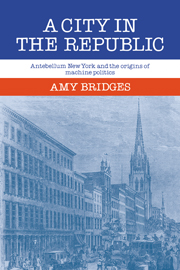Book contents
4 - THE SECOND AMERICAN PARTY SYSTEM
Published online by Cambridge University Press: 07 October 2011
Summary
New york's fellow citizens in the Jacksonian era were artisan, wage worker, and small proprietor, merchant and employer, immigrant and native-born, Protestant and Catholic. Their social differences were at times the focus of political argument and at times marginal to political debate; their antagonisms were sometimes organized into politics and sometimes fought in the street. The political environment of the antebellum city organized some differences into political life and excluded or reshaped others. That political environment had two elements. The more prominent of these was the establishment of political parties. The second was the persistence of values and habits of long standing in local politics. Cultural inheritance and Jacksonian revolution together provided a tentative political order for New York's social transformation.
In New York, as in cities across the nation, the major contenders for power between 1834 and 1850 were the Whig and Democratic parties. These parties were organized to achieve national rather than local goals. The Tammany organization had existed for decades, but found its partisan banner at the election of Jackson in 1828. Whigs were formally organized in 1834 to oppose Jackson's administration. The debate of the parties in the city was largely a repetition of their congressional argument, and local ascendancy was most valuable as a means to the larger end of national victory.
Each party had nevertheless to recruit constituencies locally. Party-building prospects may have seemed brighter in New York than elsewhere, for New York's upstate politicians had pioneered, a decade earlier, in arguing the legitimacy of party politics.
- Type
- Chapter
- Information
- A City in the RepublicAntebellum New York and the Origins of Machine Politics, pp. 61 - 82Publisher: Cambridge University PressPrint publication year: 1984



